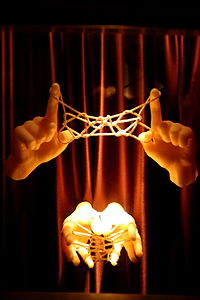|
Museum of Jurassic TechnologyThe Museum of Jurassic Technology at 9341 Venice Boulevard in the Palms district of Los Angeles, California, was founded by David Hildebrand Wilson and Diana Drake Wilson in 1988.[1][2] It calls itself "an educational institution dedicated to the advancement of knowledge and the public appreciation of the Lower Jurassic",[3] the relevance of the term "Lower Jurassic" to the museum's collections being left uncertain and unexplained.[4]    The museum's collection includes a mixture of artistic, scientific, ethnographic, and historic items, as well as some unclassifiable exhibits; the diversity evokes the cabinets of curiosities that were the 16th-century predecessors of modern natural-history museums. The factual claims of many of the museum's exhibits strain credibility, provoking an array of interpretations. David Hildebrand Wilson received a MacArthur Foundation fellowship in 2001.[5][6] OverviewThe museum contains an unusual collection of exhibits and objects with varying and uncertain degrees of authenticity. The New York Times critic Edward Rothstein described it as a "museum about museums", "where the persistent question is: what kind of place is this?"[4] Smithsonian magazine called it "a witty, self-conscious homage to private museums of yore . . . when natural history was only barely charted by science, and museums were closer to Renaissance cabinets of curiosity."[2] In a similar vein, The Economist said the museum "captures a time chronicled in Richard Holmes's recent book The Age of Wonder, when science mingled with poetry in its pursuit of answers to life's mysterious questions."[7] Lawrence Weschler's 1995 book, Mr. Wilson's Cabinet of Wonder: Pronged Ants, Horned Humans, Mice on Toast, And Other Marvels of Jurassic Technology, attempts to explain the mystery of the Museum of Jurassic Technology. Weschler deeply explores the museum through conversations with its founder, David Wilson, and through outside research on several exhibitions. His investigations into the history of certain exhibits led to varying results of authenticity; some exhibits seem to have been created by Wilson's imagination while other exhibits might be suitable for display in a natural history museum. The Museum of Jurassic Technology at its heart, according to Wilson, is "a museum interested in presenting phenomena that other natural history museums are unwilling to present."[8] The museum's introductory slideshow recounts that "In its original sense, the term, 'museum' meant 'a spot dedicated to the Muses, a place where man's mind could attain a mood of aloofness above everyday affairs'". In this spirit, the dimly lit atmosphere, wood and glass vitrines, and labyrinthine floorplan lead visitors through an eclectic range of exhibits on art, natural history, history of science, philosophy, and anthropology, with a special focus on the history of museums and the variety of paths to knowledge. The museum attracts approximately 25,000 visitors per year.[9] ExhibitsThe museum maintains more than thirty permanent exhibits, including:
From 1992 to 2006, the museum's Foundation Collection was on display in its Tochtermuseum at the Karl Ernst Osthaus-Museum in Hagen, Germany. This exhibition was part of the Museum of Museums wing at the KEOM, which came into being under the stewardship of director Michael Fehr.[10] Auxiliary functionsIn 2005, the museum opened its Tula Tea Room, a Russian-style tea room where Georgian tea and accompanying cookies are served, the cost covered by the price of admission.[11] This room is a miniature reconstruction of the study of Tsar Nicolas II from the Winter Palace in St. Petersburg, Russia.[citation needed] The tea room is shared with a number of live doves and other birds.[11][12] The Borzoi Kabinet Theater screens a series of poetic documentaries produced by the Museum of Jurassic Technology in collaboration with the St. Petersburg–based arts and science collective Kabinet. The series of films, entitled A Chain of Flowers, draws its name from the quotation by Charles Willson Peale: "The Learner must be led always from familiar objects toward the unfamiliar, guided along, as it were, a chain of flowers into the mysteries of life". The titles of the films are Levsha: The Cross-eyed Lefty from Tula and the Steel Flea (2001), Obshee Delo: The Common Task (2005), Bol'shoe Sovietskaia Zatmenie: The Great Soviet Eclipse (2008), The Book of Wisdom and Lies (2011), and Language of the Birds (2012). In popular cultureThe museum was the subject of a 1995 book by Lawrence Weschler entitled Mr. Wilson's Cabinet of Wonder: Pronged Ants, Horned Humans, Mice on Toast, and Other Marvels of Jurassic Technology, which describes in detail many of its exhibits. The museum is mentioned in the 2008 novel The Museum of Innocence, by Turkish Nobel-laureate Orhan Pamuk. References
External linksWikimedia Commons has media related to Museum of Jurassic Technology. |